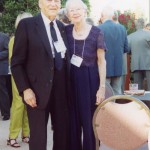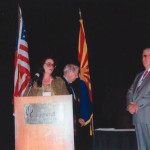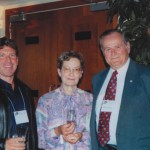By Karen Di Piazza
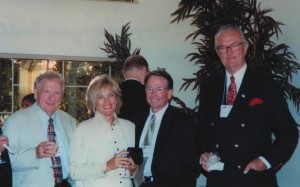
L to R: John Lane, vice president of the Arizona Aerospace Foundation with Leslie Hammond and her husband Michael Hammond, vice president of the Arizona Aerospace Foundation, and Count Ferdinand von Galen, president of the Arizona Aerospace Foundation.
More than 300 guests attended the 13th annual Arizona Aviation Hall of Fame honoree induction on May 4, 2002, held at the Chaparral Suites Resort in Scottsdale.
This year’s 2002 enshrinees, and many past inductees attended the event, which started out with cocktails and hors d’oeuvers.
Master of the ceremonies for the evening was Harry Robertson, a 1966 enshrinee and a pioneer of crashworthy fuel systems.
The ceremony, professionally handled by Qmmunication Technologies located in Tucson, orchestrated the sound effects, lighting production and tribute video with a special rising backdrop, which focused on the United States Flag and the Arizona State Flag, marched down the aisles by the Luke Air Force Base Honor Guard.
Students from the Prescott Campus of Embry-Riddle Aeronautical University escorted past and current inductees to their tables.
Tom Brokaw, anchor of NBC’s nightly news, pre-recorded a tribute to all past and current inductees, with a major focus on Brig. Gen. Joseph Foss, USAF (ret.), a 2002 inductee.
Joe Foss

2002 Arizona Aviation Hall of Fame Inductee Brig. Gen. Joseph Foss, USAF (ret.) with wife Donna, enjoys seeing old friends at the 13th annual honoree induction party.
Foss, born in Sioux Falls, S.D., in 1915, was twice elected as governor of South Dakota, was the first commissioner for the American Football League, and hosted the weekly syndicated television shows, “The Outdoorsman,” and the “American Sportsman.” He also co-authored two books, “Top Guns” and “A Proud American—Joe Foss.”
Foss, who stood proudly before hundreds of people, waited patiently before accepting his medal and plaque as the audience gave him a thunderous standing ovation. President Franklin D. Roosevelt bestowed the Medal of Honor, the nation’s highest military award, on the Marine pilot in 1943. Foss was the first American pilot to tie Capt. Eddie Rickenbacker’s 26 victories of WWI. Foss also received the Distinguished Flying Cross and is enshrined in the National Aviation Hall of Fame.
Martha and Michael Mitchell
Martha A. Mitchell and her late husband Michael F. Mitchell, both 2002 inductees, shared a love of aviation and together set new standards for the industry.
Martha was born in 1921, in Hickman County, Tenn., where she got the bug for flying from reading newspaper accounts of the glory days surrounding Amelia Earhart. Later, she flew the UC-78 and co-piloted the RB-34 as part of the USAF Weather Wing. She continued flying and eventually flew such aircraft as the B-25, B-24 and B-17 bombers as a WWII WASP (Women Airforce Service Pilots). She logged over 6,400 flight hours before her retirement in 1985.
Michael was an instrument training program instructor for Southwest Airways, which trained thousands of WWII pilots. With a perfect safety record, he logged more than 22,000 flight hours and was an FAA designated flight examiner for advanced ratings in instrument and air transport.
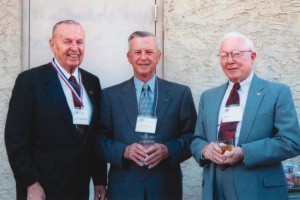
L to R: 1996 Arizona Aviation Hall of Fame inductee James Greenwood; 2002 Arizona Aviation Hall of Fame inductee, Brig. General Raymond Haupt, USAF (Ret.); and William Rafferty, trustee of the Arizona Aviation Hall of Fame.
The couple married and became owners of Sky Harbor Air Service, Inc., in Phoenix, where they ran charter, air ambulance and maintenance services, as well as a pilot supply store.
The Mitchell’s personal Beechcraft D-18 is permanently ensconced in the Smithsonian Institution’s National Air and Space Museum. Martha posthumously accepted her husband’s Arizona Aviation Hall of Fame award and medal. He developed Parkinson’s disease and died in 1993.
Gladys Mae Morrison
Edna Faye Thornburgh accepted the honor for her mother Gladys Mae Morrison, who died just days before she was to attend the ceremony.

Scottsdale Mayor Mary Manross and husband Larry Manross enjoy a quiet moment before the ceremony begins.
Morrison was born in 1928. In 1950, she became the first woman licensed to fly a crop duster in the state of California. In the 1960s, she became a partner in Indio Flying Service and Desert Air Oasis. She became assistant manager of Beechcraft West’s flight center, where she was in charge of all flight and ground training. At Fowler Aeronautics, she wrote training manuals for all of the advanced FAA ratings, including air transport pilot, and instructed in the company’s flight engineer ground school; she was the first woman to do so.
Morrison moved to Prescott, Ariz., in 1967. There she instructed, flew for the U.S. Department of Agriculture’s Forest Service and headed the Yavapai College aviation department, among other feats. In 1982, the FAA recognized her as National Flight Instructor of the Year. She most recently served as the president of North-Aire Inc., after setting up the company’s FAA approval.
Brig. Gen. Raymond Haupt, USAF (ret.)
Brig. Gen. Raymond Haupt, USAF (ret.) was born in Missouri in 1927. For the last 27 years, he has been a Tucson resident. His 30-year Air Force career included early secret test flights on some of America’s highest flying and fastest reconnaissance aircraft.
During the “Cold War,” many flights took place over hostile territories, and much of his most significant work is still classified.
He became one of the first five instructor pilots on the U-2 program and helped develop operational techniques and procedures for both the U-2 and SR-71 Blackbird. He went on to command the 100th Strategic Reconnaissance Wing. Haupt was subsequently assigned to the Joint Chiefs of Staff at the Pentagon as director of reconnaissance and electronic warfare; he was involved in security systems.
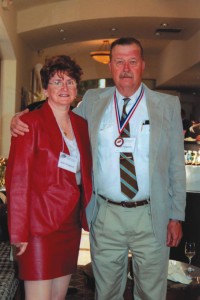
Ann Ferguson and 2001 Arizona Aviation Hall of Fame inductee Frederick Ferguson enjoy cocktails prior to the ceremony.
In 1973, he assumed command of the 12th Strategic Air Division at Davis-Monthan Air Force Base. He retired in 1975; his military decorations include two Distinguished Flying Crosses and numerous Air Medals and Air Force Commendation Medals.
Hall of Fame inductees are selected a year in advance. Sandi Moomey, the new director of development and community relations for the Pima Air & Space Museum, has already announced 2003 inductees. They are Col. Ralph D. “Hoot” Gibson, USAF (ret.), who sits on the Arizona Aerospace Foundation board of directors; Brig. Gen. Robert Wesley Waltz, deceased; Col. William S. Underwood; and Darrell Artwade Sawyer.
The Arizona Aviation Hall of Fame exhibit gallery is located in Hangar 2 of the Pima Air & Space Museum in Tucson. The hall of fame offers museum visitors a unique opportunity to acquaint themselves with noteworthy Arizona aviators. Established in 1985, the hall of fame is a permanent shrine to Arizonans who have played a role or made a significant contribution to aviation and aerospace history.
- George Steinke, 97, a 1991 Arizona Aviation Hall of Fame inductee, drove all the way from Las Vegas, with girlfriend Marge Meyers, to catch the 2002, inductee ceremony.
- 2002 Arizona Aviation Hall of Fame inductee Martha Anne Wilkins Mitchell accepts her induction plague and posthumously accepts for her husband Mike Mitchell, also a 2002 Arizona Aviation Hall of Fame inductee.
- Edna Faye Thornburgh, daughter of Gladys Mae Morrison, posthumously accepts her mother’s 2002 Arizona Aviation Hall of Fame inductee plaque.
- Phoebe, wife of 1998 Arizona Aviation Hall of Fame inductee Richard (Jerry) Snyder, catches up with old friends.
- Sandi Moomey, director of development & community relations for the Pima Air & Space Museum, beside Capt. Austin Bates, USMC (ret.).
- L to R: Gene Turner with Sonna and Hoot Gibson. Hoot Gibson will be one of four 2003 Arizona Aviation Hall of Fame’s inductees.
- Marge Meyers smiles as Harry Robertson, a 1996 Arizona Aviation Hall of Fame inductee, tells her a joke.












